| This page uses Creative Commons Licensed content from Wikipedia (view authors). |
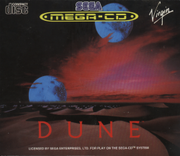
Cover of the Mega-CD version of the game
Dune, by Cryo Interactive, is one of the Dune computer games. It was the first attempt of making a commercial game based on Frank Herbert's Dune universe.
Dune blended adventure with economic and military strategy, and is considered by many the most immersive Dune computer game. Loosely following the story of the novel, the game casts the player as Paul Atreides, with the ultimate goal of driving the Harkonnen from Dune, while managing spice extraction, military, and later, ecology through the native Fremen tribes. As the player progresses, his troops are equipped with weapons from "crysknives" to atomics, tap into Paul's latent psychic powers, and get acquainted with such characters from the book as Chani and Liet Kynes. Available for the Amiga and IBM PC compatibles, it was one of the first floppy games to be converted to CD format, which included footage of the David Lynch movie, voice-acting for all speaking roles, and highly improved, 3D-rendered travelling and location screens. This version (a mix of the Amiga graphics and the extras of the PC-CD version) was also released on Sega's Mega CD format. Also worthy of mention is the audio track created by Stéphane Picq and Philip Ulrich, released by Cryo (formerly Exxos) on the now extremely rare album Dune: Spice Opera.
Overview
- Spoiler warning! Plot and/or ending details follow.
The story is mostly based on the novel's story:
The player is Paul Atreides, son of Duke Leto Atreides and Lady Jessica. The House Atreides was given an unrefusable offer by the Emperor Shaddam Corrino IV - mine the Spice Melange from the desert planet Arrakis, occupied by their long-time enemies: the House Harkonnen. Duke Leto accepts the offer not only because of the wealth provided by Spice trading, but also to defeat the Harkonnen.
The game, seen always through the eyes of Paul, is a mix between Real Time Strategy and adventure gaming. While the basis of the game is the strategy component, dialog between characters and a linear plotline give the game more depth than most strategy games. The player is also required to do some miniquests involving talking to characters and traveling to locations, which adds a small adventure game element. After arriving on Arrakis, the story itself becomes entirely different. The only Atreides character to canonically die is Duke Leto and Arrakeen is never attacked by the Harkonnen. In fact, Arrakeen already belongs to them, the Atreides Palace is located in Carthag (which belongs to Harkonnen in the book). Most of the game is spent looking for sietches and eventually directing the whole planet.
There must be a balance between military and spice mining power. While having a strong military force will provide fast response to the Harkonnen, if Spice isn't mined fast enough to keep up with the Emperor's demands, the game will be lost. However, if there is too much focus on spice mining, Harkonnen troops can ambush a sietch, capturing all troops inside. They can only be rescued if the sietch is liberated. Since the game is as much resource managing as military conquest, balancing both is the key for successful completion.
Units and items
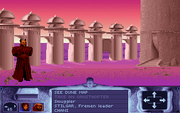
Buying from smugglers
The Atreides House has no military or spice mining units. Soon in the game, Paul must meet the closest Fremen leaders and convince them to work for him. In the beginning, they will only agree to work as spice miners. After Paul is introduced to Stilgar, the tribes will agree to work as either spice miners or military soldiers as Paul chooses. After he is introduced to Liet Kynes, the tribes can also take ecology as their occupation.
All tribes will increase their ability in their chosen occupation. Spice prospectors do so by spice prospecting in many sietches. Spice miners do so by mining spice. Military troops do so by training in their sietches (if Gurney Halleck is in the same sietch they increase their ability at a faster rate) or successfully completing military missions.
All tribes except the spice prospector tribe can change their occupations, although it is better to keep a tribe in the same occupation. Experienced spice prospectors can prospect spice faster. Experienced spice miners can mine more spice. Experienced military troops are more effective in military missions. However, there may be situations where changing a tribe's occupation is required. For example, if a large number of military troops training in a sietch is captured by Harkonnen forces, more military troops need to be raised from the spice or ecology troops to liberate the sietch and rescue the captured troops.
Although the Fremen agree to work for the Atreides in order to depose the Harkonnen, if there are tribes from both hemispheres in the same sietch, they will quarrel and refuse to work (this seems to happen frequently with the spice miners). Morale (affected by contacts with Paul, Atreides advancement in Arrakis, the progress of ecologists, and whether Chani is captured or free) also affects the speed and capabilities of the tribes.
The Ornithopter (Orni) is the default transport method for Paul until he's able to ride sandworms. With the Fremen, they are used for either moving from one sietch to another quickly or as an early warning against sandworms attacking spice miners and prevent Harvesters from being swallowed. Harvesters increase spice mining speed, and can be either bought from smugglers or found in sietches. Weaponry ranges from crysknives, laser guns, Weirding Modules and the powerful atomics, and are usually found on sietches or conquered Harkonnen fortresses.
Areas
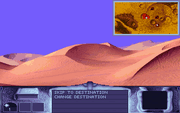
Exploring Arrakis
Arrakis is split into numerous areas, each with a single structure which Paul may visit, and other characters may be sent to. Each area has a unique name, composed of two parts. The first part of the name represents a region (like a county - for example, the areas directly surrounding the Atreides Palace are all called "Carthag-"). The regions usually comprise of 4 to 8 areas with sietches, and optionally one village (with the exception of Cielago region with just 2 areas). The structures may be any of the following:
- Palace - Both the Atreides and Harkonnen have a palace which serves as their base of operations. There are only 2 palaces.
- Sietch - Caves where the Fremen make their homes. Much of the game is spent uncovering sietches hidden in the desert to meet new troops and find new equipment. Sietches which Paul has found represent Atreides-controlled territories.
- Fortress - Harkonnen bases, usually with Harkonnen troops stationed and occasionally, captured Fremen. These bases are the targets of the player's military attacks, and represent the Harkonnen-controlled territories. On rare occasions, after winning a battle over a fortress, there will be a captive Harkonnen captain there that your troops can handcuff, allowing you to interrogate him and discover the locations of other Harkonnen fortresses, their troop numbers, and their armaments.
- Village - Neutral territories where you can find smugglers who sell equipment. There are 6 villages in total.
The vast majority of all areas are sietches and fortresses (62 together), which the battles are fought over. When one side wins a battle, their troops will transform the structure to their liking (Fremen troops transform fortresses into sietches, whereas Harkonnen troops transform sietches into fortresses).
Some sietches and villages are "marked on your map" by characters you talk to during the game but there are quite many that you have to explore yourself. This is done by taking an orni or a worm and flying/riding in the correct direction. When you get close enough, the person with you notifies you of the sighting and the sietch/village appears on your map. Therefore, you must always have someone with you to explore new areas. Though you may discover new sietches by blindly traversing over the unexplored areas which is excruciatingly inefficient, a complete map, however, is not necessary to accomplish it in a more efficient and convenient way. What helps is talking to Fremen chiefs. When a troop is stationed in a sietch in the vicinity of a not-yet-explored one, their chief will tell you that there is a sietch nearby, and in which direction. But they will only tell you this information when you talk to them personally, inside their sietch. However, most sietches and villages are only discoverable after reaching a certain stage in the gameplay, not earlier. And, of course, this stage is different for every region so that you are only able to explore the planet gradually, as the game progresses.
This here is a 100% complete map of all explorable areas which might help you during the gameplay and to discover unknown areas:
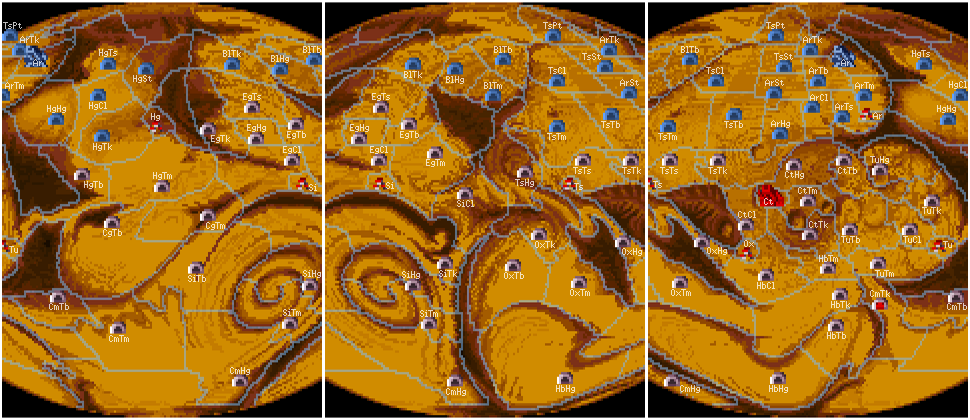
A complete Dune map with sietch names and area borders.
The names are trying to take up as little space as possible while staying self-explanatory. The first two letters are region names, the second two are sietch name within the region. Palaces and villages have no suffix as it is quite obvious (Villages are always named Region-Pyons). The regions are: Ar - Arrakeen, Ct - Carthag, Tu - Tuono, Hb - Habbanya, Ox - Oxtyn, Ts - Tsympo, Bl - Bledan, Eg - Ergsun, Hg - Haga, Cg - Cielago, Si - Sihaya, Cm - Celimyn; sietch names are: Tb - Tabr, Tm - Timin, Tk - Tuek, Hg - Harg, Cl - Clam, Ts - Tsymyn, St - Siet, Pt - Pyort. So e.g. CtTm (the prospectors' sietch) is Carthag-Timin. The Harkonnen fortresses are marked with blue, the information is based on the binary data from a 1st day savegame.
There is a sietch which is normally impossible to explore - Celimyn-Tuek, marked with a red center on the map. This is due to a bug in the game's initialization data but can be easily fixed with a hex editor without even spoiling the game by making it visible too early (or by even making it visible). A quick how-to without a deeper explanation: Save the game at any time (even in the day 1). Within the saved file, find a sequence 0C-05 (this is the sietch number internally). It should be followed by 6 bytes which may vary and another 7 going like: 03-00-80-FF-F7-04-00. By changing the FF byte to 58 you get just the right behaviour - when you reach the appropriate stage in the game, the sietch becomes explorable by flying over and even Fremen stationed nearby will notify you of its existence.
Mining and economics
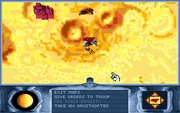
Ordering Fremen units
Each sietch/fortress area contains a quantity of spice melange. The large desert in the southern hemisphere has the largest Spice reserves, but all new areas need to be probed by the prospector troop. Once an area has been prospected, the prospectors can move on to another sietch. However, unlike in the books, Spice is not renewable in the game. After all the reserves in an area are mined, the area is permanently depleted of spice and can only be used for ecology and military training from then on.
Spice (not the Solari) is the currency in the game, and serves two purposes: paying the Emperor to be able to continue play, and purchasing equipment from smugglers. Duncan Idaho is the character in charge of your spice economy, and, when asked, will call Paul's attention to outstanding payments to the Emperor and to smugglers.
Military
Fremen specialised in military are the only troops capable of conquering a fortress or defending a sietch. They can also perform espionage on Harkonnen fortresses, reporting on the number of enemy troops and their type of armament. Fremen military troops can be ordered to attack the fortresses. A successful mission depends highly on morale, skill and armament, so early in the game espionage is much harder to achieve without the troops being captured by the Harkonnens.
Paul's presence during a battle increases the men's morale. He can boost their morale even more if he comes along on a worm and even further more he controls the battle personally (but then risks dying if the battle is lost). There are two ways for Paul to control the battle personally.
Self fighting modes
Massive Attack
Paul will order his troops to launch an immediate full scale war.
Fight for a day
Paul will order his troops to reserve their resources and fight for a whole day.
Ecology
As soon as Paul meets Liet Kynes and drinks the Water of Life, Arrakis can be terraformed by having Fremen troops specialise in ecology. Since it only happens late in the game, the northern sietches are usually barren (but any spice remaining will disappear), and by moving ecology troops there, they can assemble a windtrap, and provided they are equipped with bulbs, vegetation will always grow to the north.
Vegetation raises the morale of Fremen. In addition, planting the vegetation south to the Harkonnen controlled areas, so it will grow north and reaches them, will lower their spice production. Moreover, if enough vegetation grows north into Harkonnen fortresses, they will abandon them. A military unit must still be sent then to take over such fortresses, but there will be no one to fight with.
Nevertheless, it is generally agreed amongst players that ecology is of a lower priority than both spice mining and military, hence most players tend to deploy lesser amount of troops to ecology. However, by having enough vegetation growing north into the Harkonnen Palace, ecology is actually one of the ways to reach the end game.
Paul's abilities
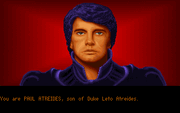
Paul Atreides as appears in the game, based on the looks of Kyle MacLachlan
At the start, Paul is given the task of meeting the Fremen. As the game progresses, he learns the ways of telepathy (progressively, from short range to planet wide) and using sandworms as transport. His charisma also influences his ability to gather Fremen under the Atreides' flag, as some chiefs will not work for Paul or do military assignments if his charisma isn't high enough. His progress can be partially seen in the mirror at the Atreides' Palace - his eyes turn more "blue on blue" (Eyes of Ibad) as his abilities increase.
Characters
The game follows loosely in-off-between the book and the 1984 movie by David Lynch (Paul Atreides was designed to look like Kyle MacLachlan, who is actually credited as Paul Atreides). Only a few characters are removed from the movie, clearly the biggest visual inspiration for the game, such as Shadout Mapes, Piter de Vries and Reverend Mother Ramallo. Some characters' roles have changed, however, such as Harah who follows Paul about in the earlier stages of the game.
End Game
Paths to The End Game
The only way to win the game is to launch an attack on the Harkonnen Palace. While technically it could be done at any given time (as long as Paul has military troops to order around), Paul's troops can't win this battle unless he launches it only after Thufir Hawat advises him to do it. Then he must follow exactly the suggestions Thufir Hawat provides him on how to win.
However, there are two alternate paths to cause Thufir Hawat to give that advise.
The military path to the end game
Thufir Hawat will advise Paul he's ready to take over Harkonnen Palace, if enough Harkonnen fortresses are taken over by Paul. Harkonnen fortresses are discovered either through espionage or when the Harkonnen manage to take over sietches.
The ecology path to the end game
Thufir Hawat will advise Paul he's ready to take over Harkonnen Palace, if so much vegetation grows north into the Harkonnen Palace, that they are forced to abandon it. Just as it is with abandoned Harkonnen Fortresses, Paul must still send troops to the Harkonnen Palace for an official takeover. However, unlike the abandoned fortresses that pose no fight, the abandoned Harkonnen Palace still can't be taken over without following Thufir Hawat's suggestions on how to beat it.
The final battle
Once Paul is advised by Thufir Hawat to take over the Harkonnen Palace, he must follow his exact suggestions on how to accomplish it. Thufir's suggestions to Paul are to ready a large number of troops (at least 10,000 men total) in the sietches around the Harkonnen Palace (only the three sietches immediately neighboring the palace count), and to also bring the bulk of Paul's ally characters to one of these sietches. When the troops and colleagues are there with Paul, Thufir Hawat suggests to launch the attack on the Harkonnen Palace.
In order to win the battle, all of the troops need to be at Expert level in fighting and carry all of the weapons available in the game (krys knives, laser guns, weirding modules, and atomics). As usual, it also boosts the troops' morale if Paul comes along on a worm and especially if he joins his troops in the fighting (in either of the two self fighting modes).
If Paul's troops win, Paul gets a vision telling him to enter the conquered palace. Once he does so, the player gets to watch an automated end game sequence featuring Paul's prisoners, including the treacherous Emperor of the Galaxy, and ends with Paul taking over as the new Emperor.
Avoiding the automated end game sequence
There is a way to avoid the automated end game sequence and keep on playing forever as the (supposedly - see below) Emperor of the Galaxy (without being able to leave Dune though). To accomplish this, as soon as Paul orders his troops to launch the final battle, he must quickly ride a worm into the battle before it could be won without him. If timed correctly and the battle is still in progress, Paul must quickly choose Massive Attack (it must be this fighting mode). The battle is then won without Paul getting a vision.
Paul must then avoid entering the conquered palace and instead go back a screen and wait for two days to pass - the standard time it takes for a conquered Harkonnen fortress to be turned into a sietch.
Paul can then enter the palace - now also turned into a sietch - at any time and talk to his new prisoners - Baron Harkonnen, Feyd-Rautha and the Emperor of The Galaxy.
From then on, the player can keep playing. There will be no one to fight with, no need to send spice to the Emperor (which, supposedly - although this way there is no official sequence to show that - is now Paul) and no new sietches to discover. At last, Paul can finally get Liet Kynes to walk around with him.
This may not work when using DOSBox emulator and the CD version of the game, but there have been documented sightings of this working even with that set-up.
Game Tips
General Tips
- If you are unsure of how to progress in the game, talk to all fremen chiefs you have discovered thus far while in their sietches - they may point you to other sietches, which might be necessary for progress to be triggered. It is best to do this when you recruit them - they rarely have more to say later that they didn't say then.
- Also, talk with all main characters (everyone in the Atreides palace, Gurney, Harah, Stilgar, Chani, and Kynes). One of them may have a task for you. This becomes less important in the latter stages of the game, as scripted events grow fewer and farther between.
- Pay attention to your visions - you usually receive them only about events that you should react to.
- Make sure to send spice shipments to the Emperor soon after he asks for them - if you fail to deliver long enough, you lose.
Travel
- Riding a worm may be cool, but ornis are much faster. However, you cannot fly an orni into Harkonnen-controlled areas - you will be shot down, resulting in a game over. You are safe on a worm in Harkonnen areas.
- Do not wander aimlessly into the desert on foot - you will die. After a few "moves" around the desert, you will see a cut image of a scorching sun. Turn back immediately at that time at the latest.
- Fremen troops will move faster between sietches if you give them an orni, but they cannot attack Harkonnen fortresses airborne (for the same reason you cannot - the Harkonnen have airspace defenses).
- If you give the spice prospector troop an orni, they will move much faster between sietches. They don't need any other equipment, nor will they benefit from it.
- Whenever exploring, it is best to have at least one companion (doesn't matter whom) - companions are needed to spot unknown sietches, and will warn you if you are flying an orni into Harkonnen airspace, giving you an option to turn back safely.
- Whenever flying an orni or riding a worm to a specific destination, the journey can be skipped using an option in the main interface. This greatly reduces tedium. Time still passes as it would otherwise if the journey is skipped.
- Prospectors need to be given three sietches to go to next, but these can include sietches that have already been prospected (in which case they will just pass through unless it is the last sietch on their route), and their movement orders can be updated (though not changed) while en route, if they are in range of your telepathy.
Spice mining
- The game has a very useful map overlay showing spice density (accessed from See Dune Map / See Spice Density). Bright yellow means the most spice in an area, while black means fully depleted, with shades of brown in between. Not all areas start at the same density.
- The spice density overlay can be switched to show sietch occupation instead (occupation can also be seen, color-coded, on mouseover of sietches in the density view).
- Speed of spice mining depends on: troop size (number of men), experience with mining (gained with time on the job), motivation (same factors as for motivation of military troops), equipment (harvester greatly increases mining speed; orni prevents swallowing of harvester by worm), and density of spice remaining in area (areas close to running dry produce little).
- You are generally fine with about 5 miner troops sized 1,500 - 2,000 men, so long as they have both harvesters and ornis. If the same troops are used from game start, by late game they will have reached Expert in mining. They can be moved from area to area once they mine a place dry.
- You may want to move troops to a new area before it completely runs out (black in spice overlay) - at ca. the last three density levels (dark shades of brown in overlay), there is very little spice left and production is slow. If needed, you may move troops back to these areas once all richer areas run out.
- The game effectively has a time limit - even if you buy nothing from smugglers (hard to win that way), the Emperor will request shipments indefinitely, with his order volumes growing by an arithmetic series. By contrast, the total volume of spice on Arrakis is fixed. Even if you destroy none through tree-planting, eventually the Emperor's demands will overtake the maximum possible mineable amount. Play times over 100 in-game days are generally not recommended.
- Planting vegetation destroys all spice in the area instantly, one step of game time passage after work is begun. When vegetation is actively grown in an area for a long time, it spontaneously spreads - always northwards - destroying all spice in any other areas it reaches once its leading edge gets there. It is recommended to grow vegetation in mined-out areas, whose northern neighbour areas are, additionally, also depleted.
- You can save some spice by haggling with smugglers over purchase prices. They will not always be amenable to it, and the discounts are not game-changing, but especially in earlier game some economies may be achieved. Preferentially haggle on more expensive items (ornis, weirding modules), as the discounts are percentage rather than flat. It is not recommended to haggle with the Emperor, as he will not tolerate that for long.
Game technology
The game was one of the first floppy disk games to be ported to the new Compact Disc format.
The Sega Mega CD version had graphics close to the Amiga Version, but offering the extras of the CD IBM compatible version. Those extras are snippets from Lynch's film, voiceovers and new travelling screens.
The game is considered to be one of the most complete of its time.
The quality of the full motion video in the Sega CD or Mega CD version was considered to be some of the best that was ever shown on the system.
Soundtrack
Virgin also released Dune: Spice Opera, a music CD from the tunes composed by Stéphane Picq. It was originally only shipped with a special version of the game, and is one of the most sought-after video-game-related music CDs, only surpassed by a few records that were only ever released in Japan.
Sequel
What is erroneously considered a sequel to this game, Dune II - The Battle for Arrakis, was not made by Cryo, but rather by Virgin Entertainment's newest acquisition, then-unknown software company Westwood Studios, in 1992. Given the success of the game, Westwood produced two more sequels, in 1998 and 2001. However, Cryo returned to the Dune universe with Frank Herbert's Dune in 2001, which was one of the final titles by the French company. The game failed on both markets and reviews, and was one of the final nails in Cryo's coffin.
External links
- Detailed information about Dune (french only)
- Dune at Squakenet
Dune video games
| |
|---|---|
|
Dune • Dune II: The Building of a Dynasty • Dune 2000 • Emperor: Battle for Dune • Frank Herbert's Dune • Dune: Spice Wars • Dune: Awakening |
